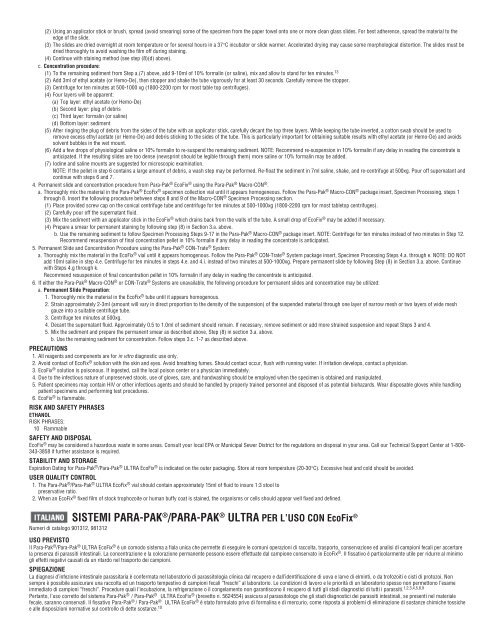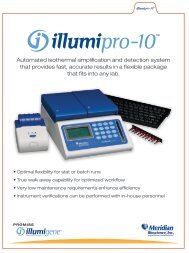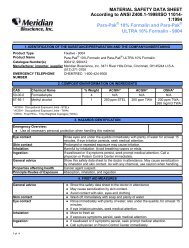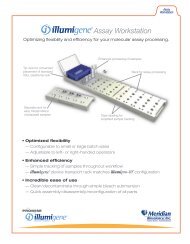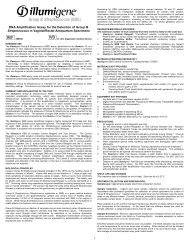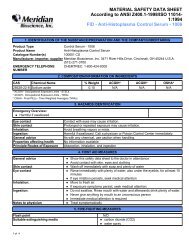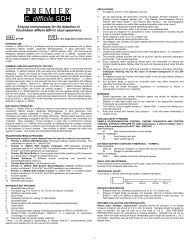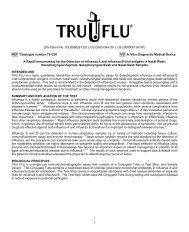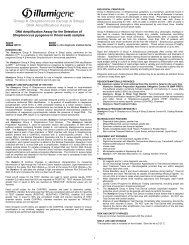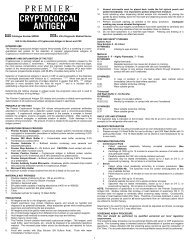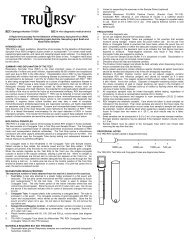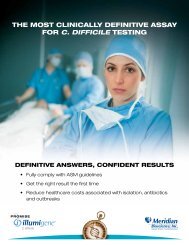PARA-PAK®/PARA-PAK® ULTRA SYSTEMS FOR USE WITH EcoFix
PARA-PAK®/PARA-PAK® ULTRA SYSTEMS FOR USE WITH EcoFix
PARA-PAK®/PARA-PAK® ULTRA SYSTEMS FOR USE WITH EcoFix
You also want an ePaper? Increase the reach of your titles
YUMPU automatically turns print PDFs into web optimized ePapers that Google loves.
(2) Using an applicator stick or brush, spread (avoid smearing) some of the specimen from the paper towel onto one or more clean glass slides. For best adherence, spread the material to the<br />
edge of the slide.<br />
(3) The slides are dried overnight at room temperature or for several hours in a 37°C incubator or slide warmer. Accelerated drying may cause some morphological distortion. The slides must be<br />
dried thoroughly to avoid washing the film off during staining.<br />
(4) Continue with staining method (see step (8)(d) above).<br />
c. Concentration procedure:<br />
(1) To the remaining sediment from Step a.(7) above, add 9-10ml of 10% formalin (or saline), mix and allow to stand for ten minutes. 13<br />
(2) Add 3ml of ethyl acetate (or Hemo-De), then stopper and shake the tube vigorously for at least 30 seconds. Carefully remove the stopper.<br />
(3) Centrifuge for ten minutes at 500-1000 xg (1800-2200 rpm for most table top centrifuges).<br />
(4) Four layers will be apparent:<br />
(a) Top layer: ethyl acetate (or Hemo-De)<br />
(b) Second layer: plug of debris<br />
(c) Third layer: formalin (or saline)<br />
(d) Bottom layer: sediment<br />
(5) After ringing the plug of debris from the sides of the tube with an applicator stick, carefully decant the top three layers. While keeping the tube inverted, a cotton swab should be used to<br />
remove excess ethyl acetate (or Hemo-De) and debris sticking to the sides of the tube. This is particularly important for obtaining suitable results with ethyl acetate (or Hemo-De) and avoids<br />
solvent bubbles in the wet mount.<br />
(6) Add a few drops of physiological saline or 10% formalin to re-suspend the remaining sediment. NOTE: Recommend re-suspension in 10% formalin if any delay in reading the concentrate is<br />
anticipated. If the resulting slides are too dense (newsprint should be legible through them) more saline or 10% formalin may be added.<br />
(7) Iodine and saline mounts are suggested for microscopic examination.<br />
NOTE: If the pellet in step 6 contains a large amount of debris, a wash step may be performed. Re-float the sediment in 7ml saline, shake, and re-centrifuge at 500xg. Pour off supernatant and<br />
continue with steps 6 and 7.<br />
4. Permanent slide and concentration procedure from Para-Pak ® <strong>EcoFix</strong> ® using the Para-Pak ® Macro-CON ® .<br />
a. Thoroughly mix the material in the Para-Pak ® <strong>EcoFix</strong> ® specimen collection vial until it appears homogeneous. Follow the Para-Pak ® Macro-CON ® package insert, Specimen Processing, steps 1<br />
through 8. Insert the following procedure between steps 8 and 9 of the Macro-CON ® Specimen Processing section.<br />
(1) Place provided screw cap on the conical centrifuge tube and centrifuge for ten minutes at 500-1000xg (1800-2200 rpm for most tabletop centrifuges).<br />
(2) Carefully pour off the supernatant fluid.<br />
(3) Mix the sediment with an applicator stick in the <strong>EcoFix</strong> ® which drains back from the walls of the tube. A small drop of <strong>EcoFix</strong> ® may be added if necessary.<br />
(4) Prepare a smear for permanent staining by following step (8) in Section 3.a. above.<br />
b. Use the remaining sediment to follow Specimen Processing Steps 9-17 in the Para-Pak ® Macro-CON ® package insert. NOTE: Centrifuge for ten minutes instead of two minutes in Step 12.<br />
Recommend resuspension of final concentration pellet in 10% formalin if any delay in reading the concentrate is anticipated.<br />
5. Permanent Slide and Concentration Procedure using the Para-Pak ® CON-Trate ® System:<br />
a. Thoroughly mix the material in the <strong>EcoFix</strong> ® vial until it appears homogenous. Follow the Para-Pak ® CON-Trate ® System package insert, Specimen Processing Steps 4.a. through e. NOTE: DO NOT<br />
add 10ml saline in step 4.e. Centrifuge for ten minutes in steps 4.e. and 4.i. instead of two minutes at 500-1000xg. Prepare permanent slide by following Step (8) in Section 3.a. above. Continue<br />
with Steps 4.g through k.<br />
Recommend resuspension of final concentration pellet in 10% formalin if any delay in reading the concentrate is anticipated.<br />
6. If either the Para-Pak ® Macro-CON ® or CON-Trate ® Systems are unavailable, the following procedure for permanent slides and concentration may be utilized:<br />
a. Permanent Slide Preparation:<br />
1. Thoroughly mix the material in the <strong>EcoFix</strong> ® tube until it appears homogenous.<br />
2. Strain approximately 2-3ml (amount will vary in direct proportion to the density of the suspension) of the suspended material through one layer of narrow mesh or two layers of wide mesh<br />
gauze into a suitable centrifuge tube.<br />
3. Centrifuge ten minutes at 500xg.<br />
4. Decant the supernatant fluid. Approximately 0.5 to 1.0ml of sediment should remain. If necessary, remove sediment or add more strained suspension and repeat Steps 3 and 4.<br />
5. Mix the sediment and prepare the permanent smear as described above, Step (8) in section 3.a. above.<br />
b. Use the remaining sediment for concentration. Follow steps 3.c. 1-7 as described above.<br />
PRECAUTIONS<br />
1. All reagents and components are for in vitro diagnostic use only.<br />
2. Avoid contact of <strong>EcoFix</strong> ® solution with the skin and eyes. Avoid breathing fumes. Should contact occur, flush with running water. If irritation develops, contact a physician.<br />
3. <strong>EcoFix</strong> ® solution is poisonous. If ingested, call the local poison center or a physician immediately.<br />
4. Due to the infectious nature of unpreserved stools, use of gloves, care, and handwashing should be employed when the specimen is obtained and manipulated.<br />
5. Patient specimens may contain HIV or other infectious agents and should be handled by properly trained personnel and disposed of as potential biohazards. Wear disposable gloves while handling<br />
patient specimens and performing test procedures.<br />
6. <strong>EcoFix</strong> ® is flammable.<br />
RISK AND SAFETY PHRASES<br />
ETHANOL<br />
RISK PHRASES:<br />
10 Flammable<br />
SAFETY AND DISPOSAL<br />
<strong>EcoFix</strong> ® may be considered a hazardous waste in some areas. Consult your local EPA or Municipal Sewer District for the regulations on disposal in your area. Call our Technical Support Center at 1-800-<br />
343-3858 if further assistance is required.<br />
STABILITY AND STORAGE<br />
Expiration Dating for Para-Pak ® /Para-Pak ® <strong>ULTRA</strong> <strong>EcoFix</strong> ® is indicated on the outer packaging. Store at room temperature (20-30°C). Excessive heat and cold should be avoided.<br />
<strong>USE</strong>R QUALITY CONTROL<br />
1. The Para-Pak ® /Para-Pak ® <strong>ULTRA</strong> <strong>EcoFix</strong> ® vial should contain approximately 15ml of fluid to insure 1:3 stool to<br />
preservative ratio.<br />
2. When an <strong>EcoFix</strong> ® fixed film of stock trophozoite or human buffy coat is stained, the organisms or cells should appear well fixed and defined.<br />
SISTEMI <strong>PARA</strong>-PAK ® /<strong>PARA</strong>-PAK ® <strong>ULTRA</strong> PER L’USO CON <strong>EcoFix</strong> ®<br />
Numeri di catalogo 901312, 981312<br />
USO PREVISTO<br />
Il Para-Pak ® /Para-Pak ® <strong>ULTRA</strong> <strong>EcoFix</strong> ® è un comodo sistema a fiala unica che permette di eseguire le comuni operazioni di raccolta, trasporto, conservazione ed analisi di campioni fecali per accertare<br />
la presenza di parassiti intestinali. La concentrazione e la colorazione permanente possono essere effettuate dal campione conservato in <strong>EcoFix</strong> ® . Il fissativo è particolarmente utile per ridurre al minimo<br />
gli effetti negativi causati da un ritardo nel trasporto dei campioni.<br />
SPIEGAZIONE<br />
La diagnosi d’infezione intestinale parassitaria è confermata nel laboratorio di parassitologia clinica dal recupero e dall’identificazione di uova e larve di elminti, o da trofozoiti e cisti di protozoi. Non<br />
sempre è possibile assicurare una raccolta ed un trasporto tempestivo di campioni fecali “freschi” al laboratorio. Le condizioni di lavoro e le priorità di un laboratorio spesso non permettono l’esame<br />
immediato di campioni “freschi”. Procedure quali l’incubazione, la refrigerazione o il congelamento non garantiscono il recupero di tutti gli stadi diagnostici di tutti i parassiti. 1,2,3,4,5,8,9<br />
Pertanto, l’uso corretto del sistema Para-Pak ® / Para-Pak ® <strong>ULTRA</strong> <strong>EcoFix</strong> ® (brevetto n. 5624554) assicura al parassitologo che gli stadi diagnostici dei parassiti intestinali, se presenti nel materiale<br />
fecale, saranno conservati. Il fissativo Para-Pak ® / Para-Pak ® <strong>ULTRA</strong> <strong>EcoFix</strong> ® è stato formulato privo di formalina e di mercurio, come risposta ai problemi di eliminazione di sostanze chimiche tossiche<br />
e alle disposizioni normative sul controllo di dette sostanze. 10


